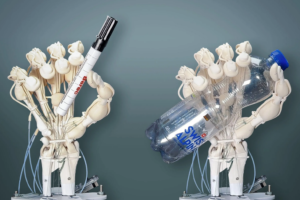
Researchers 3D-print a robotic hand with bones, ligaments, and tendons
Canadian Plastics
3D Printing Materials Research & DevelopmentScientists at ETH Zurich have succeeded for the first time in printing a robotic hand, made of different polymers, in one run.

Photo Credit: ETH Zurich/Thomas Buchner
In what’s being described as a world first, Swedish researchers and their partners in the U.S. have used thio-lene polymers to 3D-print a robotic hand complete with plastic bones, ligaments, and tendons in a single process.
The project is the result of a collaboration between researchers at ETH Zurich and a Massachusetts Institute of Technology (MIT) spin-off called Inkbit, which is based in Medford, Mass.
The group has devised a new 3D inkjet-printing technique capable of using a wider range of materials than previous devices in order to replicate the elasticity or rigidity of a human hand – which allowed them to select a slow-curing thio-lene polymer material, in a major advancement over existing 3D-printed prosthetics. Slow-curing helps minimize internal stresses that can lead to warping and shrinkage in a printed object; additionally, the slower curing process can result in stronger and more durable prints, as each layer has more time to securely bond with the previous one. The thio-lene material selected by the researchers has very good elastic properties and returns to their original state much faster after bending than polyacrylates, which are fast-curing and which the team had been using previously in other 3D printing applications.
The technology also makes it easy to combine soft, elastic, and rigid materials. “We wouldn’t have been able to make this hand with the polyacrylates we’ve been using in 3D printing so far,” said Thomas Buchner, a doctoral student in the group of ETH Zurich.
But there was a hurdle: To accommodate the use of slow-curing polymers, the researchers had to modify the 3D printing process – which typically works with fast-curing polymers – by adding a 3D laser scanner that immediately checks each printed layer for any surface irregularities; a feedback mechanism then compensates for these irregularities when printing the next layer by calculating any necessary adjustments to the amount of material to be printed in real-time.
As detailed in a recent article in Nature magazine, each of the robotic hand’s various parts were made from different polymers of varying softness and rigidity, using a new laser-scanning technique that lets 3D printers create “special plastics with elastic qualities.”
The Swiss researchers have identified several uses for the robotic hand: in prosthetics, for one, but also in any field that requires the production of soft robotic structures. “Robots made of soft materials, such as the hand we developed, have advantages over conventional robots made of metal,” said ETH Zurich robotics professor Robert Katzschmann. “Because they’re soft, there is less risk of injury when they work with humans, and they are better suited to handling fragile goods.”
